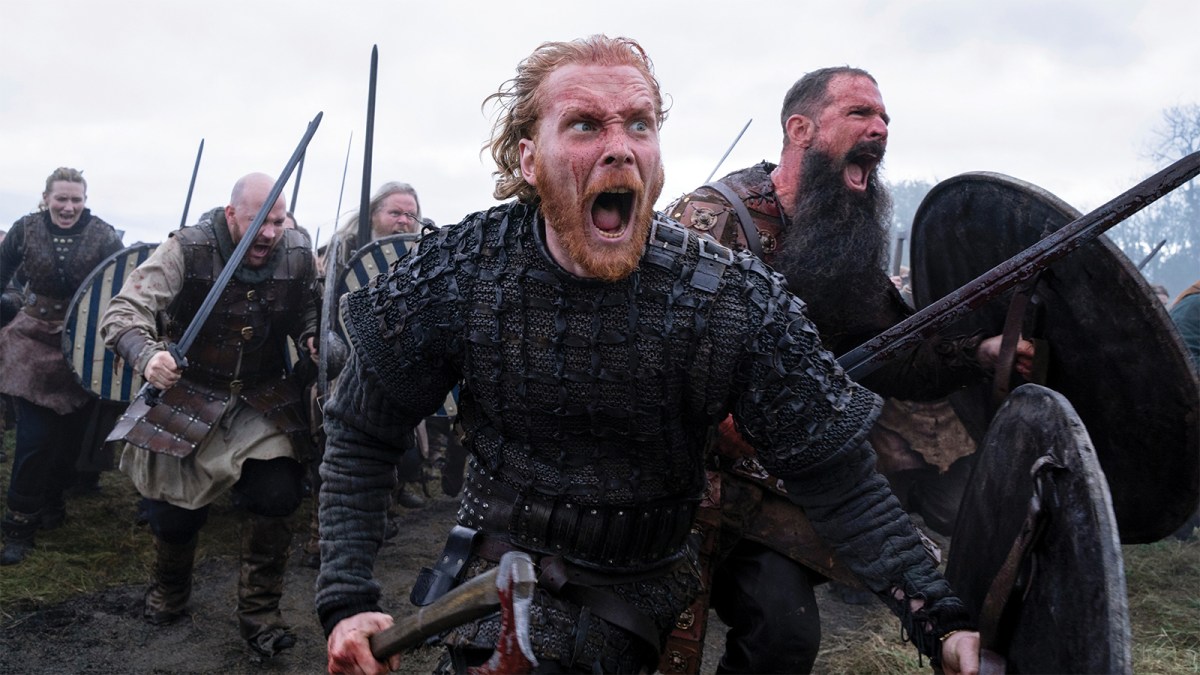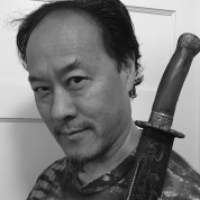How Vikings: Valhalla Forged Its Epic Battles
Stunt Coordinator Richard Ryan and Armourer John McKenna reveal how they bring the brutal fights of Vikings: Valhalla to life.

This article is presented by Netflix
When it comes to action, Vikings: Valhalla has some big tunics to fill. Its predecessor, Vikings, delivered many thrilling sword and axe skirmishes worthy of these legendary warriors. The new series reassembles the same stunt team and prop makers in hopes of capturing even more honor and glory for the noble Norsemen. Fighting through gore and muck is the Viking way, and this crew strives to engage us viscerally with the ferocious spectacle of medieval war. And Vikings: Valhalla doesn’t pull any punches. In just the fourth episode, the stunt team delivers an epic siege on London Bridge, the magnitude of which is on the level of the finale battle in most other sword-swinging series.
“Mud and blood is definitely a strong theme with us,” admits Richard Ryan, Stunt Coordinator for Vikings and Vikings: Valhalla. The franchise has a reputation for gritty brutal action and the new show brings even more epic brawls that are sure to please the most blood-thirsty fans.
Staging Combat from Live Theater to Small Screen
Ryan’s work includes Stardust (2007), The Dark Knight (2008), and Sherlock Holmes (2009) among others, but he entered the stunt biz by chance. An avid martial artist and sportsman, he learned stage combat from the legendary William Hobbs. Hobbs was the pioneering choreographer behind such swashbuckling classics as The Three Musketeers (1973), The Duellists (1977), Excalibur (1981), Rob Roy (1995), and even Game of Thrones (2011). Hobbs literally wrote the book on stage combat—actually three books—each a how-to bible in every choreographer’s library. Ryan met Hobbs by dumb luck. “He was there with a sword in one hand and a cigarette in the other, and off we went. I had a certain aptitude for it, which he very kindly encouraged.”
Ryan’s skills earned some secondary Shakespearean “fight and die” roles like Tybalt and Paris, while he continued to sharpen his fighting skills. “In tandem I was training to do fights thinking it would be a second string to my bow and make me more employable as an actor. And in fact, I was far better at that than I was at acting.” This background in theater gives Ryan’s choreography a distinct edge. Most filmed fights have a lot of scene cuts. One move, one splice is technically easier to film than a dozen-plus moves in a single shot. However, stage combat doesn’t have such luxury.
Vikings: Valhalla consistently delivers longer fight sequences with the actors doing their own stunts. “I know Bill Hobbs worked in film,” says Ryan, “but he also worked in theater and my background was starting in theater. And so as we go through it, we’re trying to get people ready to perform the fight in its entirety. That’s our goal. We’re always trying to get the actors ready to perform the fight from top to tail.”
Forging Weapons: The Secrets of the Swords
An extra challenge of a prolonged fight scene is that it’s exhausting, even for fit stuntpeople. “They kind of go suddenly, ‘Oh Jesus, these are heavy,’” says John McKenna about prop weapons. McKenna doesn’t hammer steel blades in a fiery forge. He traded his anvil for CNC machines (a machine which uses a programme to control tools for precision working) long ago. “The steel blades haven’t seen action in 20-30 years now. You couldn’t even get on-set with them. You’d be just thrown off.”
“You’ll be horrified to know we don’t even use metal in the show anymore,” continues McKenna. “We’re in the world of bamboo.” Bamboo blades are set in two types of hilts on Vikings: Valhalla. Background characters get hilts of rubber. Leading roles are upgraded to solid bronze castings. “The background can use it. The cast can use it, and the stunt guys just love it. It’s lightweight. It paints up as best you can.” When a blade breaks, and they often do, it’s replaced with a twist of an Allen key.
Vikings began on the History Channel, so Vikings: Valhalla still strives for accuracy. “We’re trying to keep the weapons as historically correct as we can,” claims McKenna. “The swords are based on finds. They’re museum pieces that have been regenerated and dialed up and looked at. They’ll look as close as possible to Viking weapons of that time.”
Bloody Battles
Action is so essential to Vikings: Valhalla that Ryan’s name appears before the cast’s in the end credits. Like McKenna, he aims for historical accuracy too, but it’s trickier because the Vikings didn’t leave any notable treatises on how they fought. “I’ll research as much as I can and talk to friends that I have in the HEMA (Historical European Martial Arts) world, and people who are much more cognizant of history than I.” However, Vikings: Valhalla is not a documentary, so Ryan prioritizes keeping the action fresh. “You need to do something slightly different, so you’re not repeating the same musical number, as it were, over and over and over.” Ryan’s focus is on creating “a truthful fight,” one that captivates the audience while moving the story forward. “I’ll sprinkle it with historical authenticity, but that’s not going to be my main driver. Sorry to anybody who is upset by that.”
Viking ruthlessness is legendary, so Vikings: Valhalla is full of slit throats and axe chops to the face. “We like to keep it nice and brutal,” confesses Ryan. “There’ll be certain beats and elements that have to be in there, that the character maybe has to be wounded on the left thigh, or run through the right shoulder, or whatever it might be.” The gratuitous carnage is often driven by the effects team. “They’ll go, ‘Hey, how about this?’ And then we’ll go, ‘Oh yeah, let’s work that in.’”
Ryan also prefers real blood splatter as opposed to post-production special effects. “We’re trying to use the ‘real’ wherever possible, so when we’re doing anything that’s a battle or a fight, you’ll certainly have somebody spritzing blood as they go through.” Discerning viewers can tell when it’s CGI blood. “A beheading or a whatever, would be more digital,” concedes Ryan, but actual spraying blood draws a more authentic reaction from the actors. “It’s more visceral when they get that as they go, even though they might be sticky by the end of the day.” He says they sometimes complain about getting so bloody, especially on hot days when stage blood gets stickier, or if there are wasps. “There’s sugar in it, so it might attract them.”
London Bridge is Falling Down
With brutal battles peppering every episode of season one, it’s tough to spotlight just one. But the spectacular mid-season melee is a noteworthy centerpiece—an attack on London Bridge. It’s a testament to Ryan’s sanguineous artistry. “That one was tricky just because you’re on a bridge, you’ve got horses galloping, with stunts and extras. So there’s a couple hundred plus people on there, plus horses. So that’s always challenging because horses have a mind of their own.”
Armourer McKenna agrees. It’s his job to arm all those fighters. “It’s big,” says McKenna. “It’s maybe 200 swords, maybe 100 axes. There’s nearly, what, 200, 300, 400 shields by the time you count them all up? 40 or 50 knives. You’re talking several hundred pieces, plus spares, as in blades. A lot of everything.”
Sustainable Stunts
Many series have hinged upon top-quality fight choreography, but it’s harder to manage on TV than in movies. Ryan explains. “If you’re doing a film, you may have 10 or 12 major events to choreograph. And then as you’re going through, you are checking them off and you’re doing it, and you’re moving to the next one. On an ongoing series, it’s relentless. You’ll have 12 major things for an episode. You’ll cross off three, and you’ll go back to your list, and you’ll have 15 because the next episode is coming at you.”
This is why so many fight-based shows fail. They gas out before the season ends. Ryan credits his principal fight team—Matt McKay, Michael Redmond, Lee McDermott, and Jinny Lofthouse—with helping them make it through.
McKenna is thrilled to keep making weapons as long as Vikings: Valhalla runs. “Whatever the scripts throw at us, we will endeavor, always, to come up with answers. Take it as it comes, one weapon at a time.”
